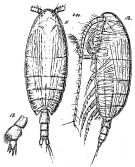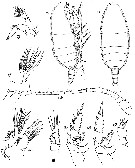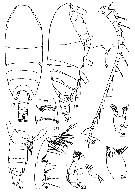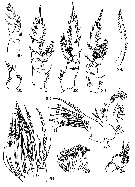|
|
 |
Fiche d'espèce de Copépode |
|
|
Calanoida ( Ordre ) |
|
|
|
Clausocalanoidea ( Superfamille ) |
|
|
|
Phaennidae ( Famille ) |
|
|
|
Xanthocalanus ( Genre ) |
|
|
| |
Xanthocalanus obtusus Farran, 1905 (F) | |
| | | | | | | Ref.: | | | Farran, 1905 (p.40, Descr.F, figs.F); Wolfenden, 1908 (p.35, Rem.); Sars, 1925 (p.131, figs.F); Rose, 1933 a (p.130, figs.F); Bradford & al., 1983 (p.71); Vyshkvartzeva, 2002 (p.94, figs.F); Markhaseva & Schnack-Schiel, 2003 (p.112, Rem.) |  Issued from : G.O. Sars in Résult. Camp. Scient. Prince Albert I, 69, pls.1-127 (1924). [Pl.XXXV, figs.11-13]. Female: 11, habitus (dorsal); 12, idem (lateral left side); 13, P5.
|
 issued from : G.P. Farran in Ann. Rep. Fish. Brch., Ireland, 1902-1903, II, App. 2, 1905. [Plate IX, Figs.10-19]. Female (from W Ireland): 10-11, habitus (lateral and dorsal, respectively); 12, A1; 13, A2; 14, Mx1; 15, Mx2; 16-19, P1 to P4.
|
 Issued from : N.V. Vyshkvartzeva in Zoosyst. Rossica , St. Petersburg, 2002, 11. [p.95, Figs.17-26]. Female (from 45°11'N, 152°28'E): 17-18, habitus (dorsal and lateral, respectively); 19, rostrum (ventral view); 20, 5th thoracic segment with P5 and urosome (right side); 21, genital segment (ventral); 22, A1; 23, A2; 24, Md (masticatory edge of gnathobase); 25, Md palp; 26, Mxp. Nota: - Cephalosome and 1er pedigerous segment, 4th and 5th thoracic segments separated by fine sutures. - Rostrum as a short plate with 2 fine filaments. - Posterolateral corners of last thoracic segment slightly produced, broadly rounded in lateral view, triangular in dorsal view. - Urosome as long as 1/4 of prosome. - Genital segment as long as wide, laterally with a small genital swelling in distal half of segment. Transverse common genital opening (fig.21) located ventrally just before midlength of genital segment; lateral triangular skeletal plates well developed; spermatheca elongate, its distal part curved forward. - Urosomal segments 2 and 3 wider than long. - Posterior margin of Urosomal segments 1-3 striated. - Caudal rami longer than wide, with 4 long apical and short inner and outer setae. - A1 24-segmented, reaching posterior margin of urosomal segment 1. - Coxa of A2 with 1, basis and endopodal segment 1 with 2 setae; 2nd endopodal segment with 6+7 setae; endopod as long as 2/3 of exopod; exopodal segments 1-6 with 0, 1, 1, 1, 1, 0+3 setae, respectively. - Md gnathobase with 10 teeth and 1 dorsal, slender, spinulose seta. 3 ventral teeth with tall and narrow multicusped crowns; central and dorsal teeth shorter, without crowns; one tip of dorsalmost tooth remarkably elongate, as long as dorsal seta; basis with 2 strong inner setae; endopodal segment 1 without setae; 2nd endopodal segment with 8 setae; endopod as long as exopod.
|
 Issued from : N.V. Vyshkvartzeva in Zoosyst. Rossica , St. Petersburg, 2002, 11. [p.96, Figs.27-35]. Female: 27, Mx1; 28, Mx2 (inner lobes 1 to 5); 28a, Mx2 claw-like seta of inner lobe 5 in another position; 29, Mx2 (sensory setae of distal endopodal complex); 30, P1; 31, P2; 32, P3; 33, P4; 34, P5 (dorsal side); 35, P5 (two distal segments, ventral side). Nota: - Mx1: inner lobe 1 (= arthrite) with 9 marginal, 4 tapering, with short spinules posterior (S11-S14), and 1 short, slender anterior setae (S6). Marginal setae longer than inner lobe 1, and their lengths remarkably increase distally; S1 and S2 tapering towards the tip, with long staff spinules; S3-S5 and S10 strongly sclerotized, with scythe-like tip, with setules along their length and sharp spinules along proximal margin in distal half. inner lobe 2 with 2 long and 1 short setae; inner lobe 3 with 2 long and 2 shorter setae; inner lobe 4 with 3 long and 2 shorter setae; endopod partly fused with basis; endopodal segment 2 fused with the 1st, each with 2 very long and 1 short setae; endopodal segment 3 with 4 setae; exopod with 10 and outer lobe 1 with 9 setae. - Mx2 compact. Inner lobes 1-3 short, subequal; inner lobe 1 with 5 setae (3 long plumose and 2 naked and shorter); inner lobe 2 with 2 long plumose and 1 shorter but more coarsely plumose setae; inner lobe 3 with 1 long plumose and 1 shorter plumose seta and short worm-like sensory seta; inner lobe 4 with 1 long plumose seta, 1 shorter and more coarsely plumose seta and 1 more strongly sclerotized long seta with long, strong, dense spines; inner lobe 5 with 1 strong claw-like seta furnished with 31 strong widely spaced spines, 1 slightly longer plumose seta and 2 worm-like sensory setae; distal endopodal complex (fig.29) indistinctly 4-segmented, with 7 brush-like and 1 worm-like sensory setae; brush-like setae slender, slightly differing in length. - P5 uniramous, 3-segmented; proximal segment slightly longer than wide, with patch of short, thickened spinules along inner margin and on outer distal margin; 2nd segment about as long as wide, globular, slightly longer than distal segment, with patches of spinules along inner margin and distal half of lateral margin and with a row of long, lancet-like spinules on posterior surface; distal segment the shortest, separated from preceding only on one side; posterior surface covered woth spinules; segment bearing 4 serrate spines (1, the longest, inner; one, outer, 293 times as long as inner, situated opposite to the inner, and 2 apical, inner apical as long as outer, outer apical slightly shorter).
| | | | | Ref. compl.: | | | Pearson, 1906 (p.20); Sewell, 1948 (p.501); Grice & Hulsemann, 1967 (p.16); Campaner, 1978 a (p.968, Rem.); Bradford-Grieve, 2004 (p.284) ; Salah S. & al., 2012 (p.155, Tableau 1); El Arraj & al., 2017 (p.272, table 2); | | | | NZ: | 5 | | |
|
Carte de distribution de Xanthocalanus obtusus par zones géographiques
|
| | | | | | | Loc: | | | Morocco (Cap Ghir), Madeira, Azores, off S Cape Cod, W Ireland, W Indian, NW Pacif. (off E Kuril Is.) | | | | N: | 9 | | | | Lg.: | | | (1) F: 3,3; (32) F: 2,4; (58) F: 2,4; (878) F: 3,12; {F: 2,40-3,30} | | | | Rem.: | bathypélagique (1465-1500 m), hyperbenthique
Voir aussi les remarques en anglais | | | Dernière mise à jour : 25/10/2022 | |
|
|
 Toute utilisation de ce site pour une publication sera mentionnée avec la référence suivante : Toute utilisation de ce site pour une publication sera mentionnée avec la référence suivante :
Razouls C., Desreumaux N., Kouwenberg J. et de Bovée F., 2005-2025. - Biodiversité des Copépodes planctoniques marins (morphologie, répartition géographique et données biologiques). Sorbonne Université, CNRS. Disponible sur http://copepodes.obs-banyuls.fr [Accédé le 23 août 2025] © copyright 2005-2025 Sorbonne Université, CNRS
|
|
 |
 |







